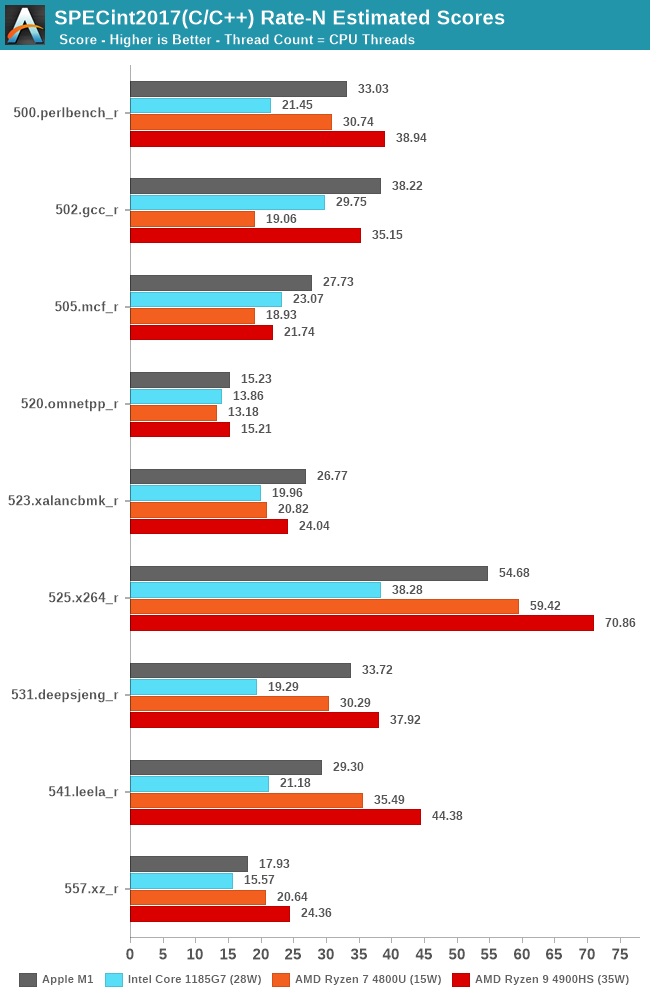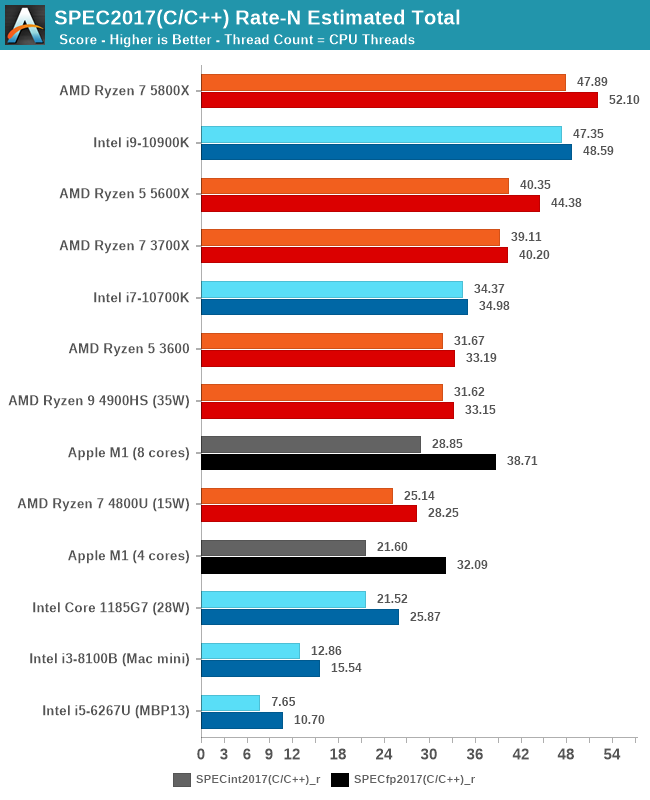The 2020 Mac Mini Unleashed: Putting Apple Silicon M1 To The Test
by Andrei Frumusanu on November 17, 2020 9:00 AM ESTSPEC2017 - Multi-Core Performance
While we knew that the Apple M1 would do extremely well in single-threaded performance, the design’s strengths are also in its power-efficiency which should directly translate to exceptionally good multi-threaded performance in power limited designs. We noted that although Apple doesn’t really publish any TDP figure, we estimate that the M1 here in the Mac mini behaves like a 20-24W TDP chip.
We’re including Intel’s newest Tiger Lake system with an i7-1185G7 at 28W, an AMD Ryzen 7 4800U at 15W, and a Ryzen 9 4900HS at 35W as comparison points. It’s to be noted that the actual power consumption of these devices should exceed that of their advertised TDPs, as it doesn’t account for DRAM or VRMs.

In SPECint2017 rate, the Apple M1 battles with AMD’s chipsets, with the results differing depending on the workload, sometimes winning, sometimes losing.

In the fp2017 rate results, we see similar results, with the Apple M1 battling it out with AMD’s higher-end laptop chip, able to beat the lower TDP part and clearly stay ahead of Intel’s design.

In the overall multi-core scores, the Apple M1 is extremely impressive. On integer workloads, it still seems that AMD’s more recent Renoir-based designs beat the M1 in performance, but only in the integer workloads and at a notably higher TDP and power consumption.
Apple’s lead against Intel’s Tiger Lake SoC at 28W here is indisputable, and shows the reason as to why Apple chose to abandon their long-term silicon partner of 15 years. The M1 not only beats the best Intel has to offer in this market-segment, but does so at less power.
I also included multi-threaded scores of the M1 when ignoring the 4 efficiency cores of the system. Here although it’s an “8-core” design, the heterogeneous nature of the CPUs means that performance is lop-sided towards the big cores. That doesn’t mean that the efficiency cores are absolutely weak: Using them still increases total throughput by 20-33%, depending on the workload, favouring compute-heavy tasks.
Overall, Apple doesn’t just deliver a viable silicon alternative to AMD and Intel, but actually something that’s well outperforms them both in absolute performance as well as power efficiency. Naturally, in higher power-level, higher-core count systems, the M1 can’t keep up to AMD and Intel designs, but that’s something Apple likely will want to address with subsequent designs in that category over the next 2 years.










682 Comments
View All Comments
BushLin - Wednesday, November 18, 2020 - link
Do you have any idea what you're talking about or is it simply that whatever Apple are doing must be ideal?I'm sure Intel are gutted about continuing to not meet the huge demand for their x86 chips on a fabrication process two generations out of date.
Also, the same power envelope AMD is beating out the M1 on an old design and fab process.
Spunjji - Monday, November 23, 2020 - link
@BushLin - "I'm sure Intel are gutted about continuing to not meet the huge demand for their x86 chips on a fabrication process two generations out of date."This is the exact kind of nonsense that makes me disappointed every time I see a reply from you to one of my posts on this thread.
BushLin - Monday, November 23, 2020 - link
I was replying to "It’s just simply that x86-64 is a hinderance to AMD and Intel"Maybe don't take technical/factual matters so emotionally. Also, wasn't a reply to you unless you have many accounts.
NetMage - Monday, November 23, 2020 - link
Maybe take your own advice?BushLin - Tuesday, November 24, 2020 - link
How many accounts do you need?markiz - Thursday, November 19, 2020 - link
Ok, but do you imagine apple will not have advanced by then?I'm pretty sure they have a long pipeline ready for the next decade.
Steven Choi 4321 - Friday, November 20, 2020 - link
Sure, amd wins with $700 chip vs $40 M1. Amd and intell are the nokia and blackberry of the time.hagjohn - Tuesday, November 24, 2020 - link
AMD is killing it. M1 is the entry level CPU (SoC) attempt from Apple. I think it is pretty good, considering it can go up against an i9. The way the M1 SoC is put together has some advantages and disadvantages. A big disadvantage is everything is build on the SoC, so if you want to add memory or change out an SSD, you are out of luck. Anything that breaks in the SoC and you need a new computer. A big advantage is that with everything on the SoC, Apple has removed a lot of the latency that we can see in intel/AMD systems.And remember... M1 is the entry level CPU (SoC) from Apple. Wait till we get towards the more Pro versions.
name99 - Wednesday, November 18, 2020 - link
Andrei, are those L1$ bandwidth numbers correct? They look off to me.Specifically 100~3*2*16, ie 3GHz times 2 loads/cycle, each 128 hits (ie 16B) wide. (Either load pair of int registers, or load of a neon register).
BUT the A14 article said there were three load units...
Are three loads/cycle only sustainable for a very short time?
A second item of interest is does the test even try to use Load Pair or Load Pair Nontemporal of two NEON registers? Earlier A cores had a 128bit per load/store unit path to L1, so there was no bandwidth win in loading a pair of vectors, but at some point presumably this might change...
Frantisek - Sunday, December 20, 2020 - link
Are you planing to review any of M1 laptops so you can cover results in comparable laptops tests?